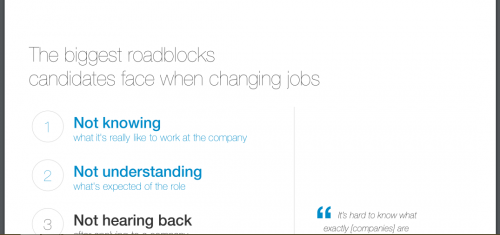Employer Branding 101: Why Employers Are Dissatisfied With So Many of Their Hires

I recently saw the alarming (but not shocking) statistic that 95 percent of companies say they recruit the wrong people every year.
Albert Einstein allegedly once said that insanity is “continuing to do the same thing over and over again while expecting a different result.”
On that note, I have a message for employers:
For the love of G-d, if 95 percent of you are making bad hires, then you’re the ones who have a problem. Don’t blame recruiters for poor matches; don’t blame candidates who lie on their resumes; don’t blame your staff for whatever nonsense you want to put on them.
If you want to change your situation, the first step is to look at yourself.
Are there things involving the other parties mentioned that can likely be improved? Absolutely. But, as it is with life, insanity is when we wait for other people to change instead of “being the change we wish to see.”
My advice: Let it begin with you.
Overhaul Your Job Descriptions to Attract Top Talent
Employer branding is one of the most critical areas in which companies must invest if they want to thrive in the current digital marketplace.
According to LinkedIn’s Global Recruiting Trends 2017 report, “While nearly 70 percent of recruiting budgets are spent on job boards, recruiting tools, and staffing agencies, talent leaders identify employer branding as the No. 1 area where they wish they could invest more.”
It seems pretty evident that the choice is yours and yours alone – you can either go with the current or stay in the storm and capsize.
Here’s a very simple place to start: Change the awfully obscure and verbose descriptions of your job openings to attract top talent instead of the unsatisfactory candidates you currently attract.
A short back story: Part of the purpose for writing this article is because I have recently begun doing some independent contracting for the fine folks at Recruiter.com. I’ve seen the job descriptions posted by some companies here. Though many are a bit better than the ones I see elsewhere, some are still plain awful.
Recently, I reached out to a candidate about her interest in a director of marketing position. She asked me for some more specific details regarding what the role entailed. While I am tempted to share the job description this company offered for this particular role to illustrate my point here, I know that wouldn’t be fair to share publicly. So let’s just say it was as dry and as jargon-filled as a cardiologist’s written report on a patient.
More importantly, it didn’t really give any clarity about what the job was actually about.
If you’re reading this and starting to feel defensive, let me first say that I can appreciate how difficult it can be to make a change. If you are currently happy with the results you are getting from your job posts, maybe you don’t need to change. In that case, you probably don’t need to continue reading this article.
However, the fact is that companies have been sending out dry, lengthy, and boring job descriptions for decades now. It’s been the standard, but why continue on with this standard just because it’s what you’ve done for so long? It’s clear that this method is no longer working effectively.
Change is the only constant in this world. The sooner we can accept that and start looking into new, creative ways of doing things, the better off we will be. That which does not grow will simply shrivel and die.
So, if you are one of those employers dissatisfied with your hires, you need to be shaken up a little. (Or a lot.)
To support my point even more, here’s a screenshot of some of the data from LinkedIn’s recruiting trends report:

Interesting. In our world of constant distraction and information overload, a company description that sounds like my graduate school reader on psychopharmacology isn’t helping potential hires understand what it’s really like to work at the company or what’s expected in the role? I can’t say I’m the least bit surprised.
So what are the options for your company when your job descriptions aren’t cutting it?
Option A: Continue to do what you’ve always done. Continue to confuse the heck out of potential talent. Continue to be dissatisfied with your candidates. Wash, rinse, repeat.
Option B: Sit around and watch as your competitors adapt to the times, improve their employer brands, and snag all the top talent from right under your nose.
Option C: Be the company that adapts, experiments, and improves its employer brand to match the time in which we live. Snag all the top talent away from the companies that go with options A and B because they remain too scared or prideful to make a change.
What Your New Job Description Should Look Like:
I’ll even give you an idea for a strategy to start. Instead of posting the driest, wordiest, and most basic descriptions (that nobody reads and retains anyways), leave the jargon for your new hire welcome packet. (That way, you can abide by any necessary HR or corporate policies while not scaring away potential candidates.)
In your job descriptions, you should describe to candidates exactly what they would be doing on an average day (or week) on the job. Don’t worry – that doesn’t mean you have to give away any sensitive company information.
For instance, let’s say that Recruiter.com were the company looking to hire someone for the role of senior director of marketing. Here’s a sample job description the company could post:
This position is for an incredible opportunity to be the senior director of marketing at one of the most widely used recruiting platforms in the world.
Here at Recruiter.com, we have spent years working around the clock to be the absolute best at what we do. We believe that recruiting is a people-centric business. We keep the human touch in recruiting by first sourcing from our awesome community of recruiters and then routing all applicants through our internal team of recruiting professionals.
As the director of marketing, you will get to work alongside CEO Miles Jennings and the rest of our executive team, who have dedicated their entire careers to understanding the inner workings of the recruiting and hiring world on both the employer side and the job seeker side. Our team is extremely passionate about closing the increasing gap between employers and job seekers in our digital world.
Just this month, our company announced a partnership with Opus Recruitment Solutions, a leading global recruitment firm with more than 100 million dollars in recruiting revenue. The partnership is projected to bring more than 150 million dollars’ worth of available specialized search fees to the Recruiter.com platform.
Your job, should you choose to accept it, would be to lead our marketing team to make sure we are highlighting all of the amazing new partnerships and site improvements that we will be bringing to employers, recruiters, and job seekers alike. We want someone who has the experience, bravado, and creativity to lead our ambitious team to reach more people than ever this year – and every year after.
As the director of marketing, you will be heading a team of five (5) people, and reporting to Miles directly every week regarding new strategies and updates.
This is an incredible time for our company, and we are looking forward to having a marketing director who can help us continue with this momentum and spread our company’s value and mission on a global level.
Here at Recruiter.com, we pride ourselves on being the best, and we are looking for the best to join us.
Now, maybe you want to let what you’ve just read sink in for a second. Seriously – how did you feel reading this description? Did you get a general understanding of the type of role you would have, the mission and vision of the company, and the basic expectations of your position?
It would be very hard to convince me that this sample posting wouldn’t get you so much more excited for the role than all the other postings that read: “Here at Dry, Dull, and Boring, Inc., we are looking for a new director of marketing. In this role, you will be implementing new strategies aligning with infrastructure of technical support educational guidelines. You will maintain alignment with communication strategy to ensure a consistent strategic direction and messaging. Blah blah blah.”
So, there’s a good place to start. If you chose option C above, start thinking about how you can more clearly communicate your brand to potential talent. As Lao Tzu once wrote, “A journey of a thousand miles begins with one single step.”
Scott Engler is the author of The Job Inner-View and Legends of the Recruiting and Career World. Read his latest, The Problem and the Solution, on his website.

